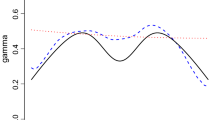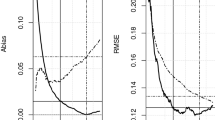Abstract
One of the most important problems involved in the estimation of Pareto indices is the reduction of bias in case the slowly varying part of the Pareto type model disappears at a very slow rate. In other cases, when the bias problem is not so severe, the application of well-known estimators such as the Hill (1975) and the moment estimator (Dekkers et al. (1989)) still asks for an adaptive selection of the sample fraction to be used in such estimation procedures. We show that in both circumstances, solutions can be constructed for the given problems using maximum likelihood estimators based on a regression model for upper order statistics. Via this technique one can also infer about the bias-variance trade-off for a given data set. The behavior of the new maximum likelihood estimator is illustrated through simulation experiments, among others for ARCH processes.
Similar content being viewed by others
References
Balkema, A. and de Haan, L., “Residual life at great age,” Ann. Probab 2, 792–804, (1974).
Beirlant, J., Vynckier, P., and Teugels, J.L., “Tail index estimation, Pareto quantile plots, and regression diagnostics,” J. Amer. Statist. Assoc 91, 1659–1667, (1996).
Bingham, N.H., Goldie, C.M. and Teugels, J.L., Regular Variation, Cambridge University Press, Cambridge, (1987).
Caers, J., Vynckier, P., Beirlant, J., and Rombouts, L., “Extreme value analysis of diamond size distributions,” Math. Geology 28, 25–43, (1996).
Csörgő, S., Deheuvels, P., and Mason, D.M., “Kernel estimates of the tail index of a distribution,” Ann. Statist. 13, 1050–1077, (1985).
Csörgő, S. and Viharos, L., “Estimating the tail index,” In: Asymptotic Methods in Probability and Statistics, (B. Szyszkowicz, ed), North-Holland, Amsterdam, 833–881, (1998).
Danielsson, J., de Haan, L., Peng, L., and de Vries, C.G., Using a bootstrap method to choose the sample fraction in tail index estimation, Technical report, TI 97-016/4, Tinbergen Institute Rotterdam, (1997).
Danielsson, J. and de Vries, C.G., Beyond the sample: Extreme quantile and probability estimation, Mimeo, Tinbergen Institute Rotterdam, (1997).
Davison, A.C. and Smith, R.L., “Models for exceedances over high thresholds,” J.R. Statist. Soc. B 52, 393–442, (1990).
Dekkers, A.L.M., Einmahl, J.H.J., and de Haan, L., “A moment estimator for the index of an extreme value distribution,” Ann. Statist. 17, 1833–1855, (1989).
Drees, H., “Refined Pickands estimators of the extreme value index,” Ann. Statist. 23, 2059–2080, (1995).
Drees, H., “On smooth statistical tail functionals,” Scand. J. Statist. 25, 187–210, (1998).
Drees, H., “Optimal rates of convergence for estimates of the extreme value index,” Ann. Statist. 26(1), 434–448, (1998).
Drees, H. and Kaufmann, E., “Selecting the optimal sample fraction in univariate extreme value estimation,” Stoch. Proc. Applications 75, 149–172, (1998).
Embrechts, P.A.L., Klüppelberg, C., and Mikosch, T., Modelling Extremal Events for Insurance and Finance, Springer-Verlag, Berlin, Heidelberg, (1997).
Hall, P., “On some simple estimates of an exponent of regular variation,” J. Roy. Statist. Soc. B 44, 37–42, (1982).
Hall, P., “Using the bootstrap to estimate mean squared error and select smoothing parameter in nonparametric problems,” J. Multivariate Anal. 32, 177–203, (1990).
Hall, P. and Welsh, A.H., “Best attainable rates of convergence for estimates of parameters of regular variation,” Ann. Statist. 12, 1079–1084, (1984).
Hill, B.M., “A simple general approach to inference about the tail of a distribution,” Ann. Statist. 3, 1163–1174, (1975).
Hosking, J.R.M., Wallis, J.R., and Wood, E.F., “Estimation of the generalized extreme-value distribution by the method of probability-weighted moments,” Technometrics 27, 251–261, (1985).
Kratz, M. and Resnick, S., “The qq-estimator of the index of regular variation,” Commun. Statist. Stochastic Models 12, 699–724, (1996).
Pereira, T.T., A spacing estimator for the extreme value index, Technical report, DEIO, University of Lisbon, (1998).
Pickands III, J., “Statistical inference using extreme order statistics,” Ann. Statist. 3, 119–131, (1975).
Pictet, O.V., Dacorogna, M.M., and Müller, U.A., “Hill, Bootstrap and Jackknife Estimators for Heavy Tails” In: A Practical Guide to Heavy Tails, (R.J. Adler, R.E. Feldman and M.S. Taqqu, eds), Birkhäuser Publishers, 55–79, (1998).
Resnick, S. and Staăricaă, C., “Tail index estimation for dependent data,” To appear in Ann. Appl. Probability, (1998).
Rootzen, H., Leadbetter, M., and de Haan, L., Tail and quantile estimation for strongly mixing stationary sequences, Technical Report 292, Center for Stochastic Processes, Department of Statistics, University of North Carolina, Chapel Hill, NC 27599-3260, (1990).
Scholz, F.W., Nonparametric tail extrapolation, Technical report. ISSTECH-95-014, Boeing Information & Support Services, (1995).
Smith, R.L., “Estimating tails of probability distributions,” Ann. Statist. 15, 1174–1207, (1987).
Smith, R.L., “Extreme value analysis of environmental time series: an application to trend detection in groundlevel ozone,” Statist. Sci. 4, 367–393, (1989).
Schultze, J. and Steinebach, J., “On least squares estimates of an exponential tail coefficient,” Statist. Decisions 14, 353–372, (1996).
Weissman, I., “Estimation of parameters and large quantiles based on the k largest observations,” J. Amer. Statist. Assoc. 73, 812–815, (1978).
Author information
Authors and Affiliations
Rights and permissions
About this article
Cite this article
Beirlant, J., Dierckx, G., Goegebeur, Y. et al. Tail Index Estimation and an Exponential Regression Model. Extremes 2, 177–200 (1999). https://doi.org/10.1023/A:1009975020370
Issue Date:
DOI: https://doi.org/10.1023/A:1009975020370




